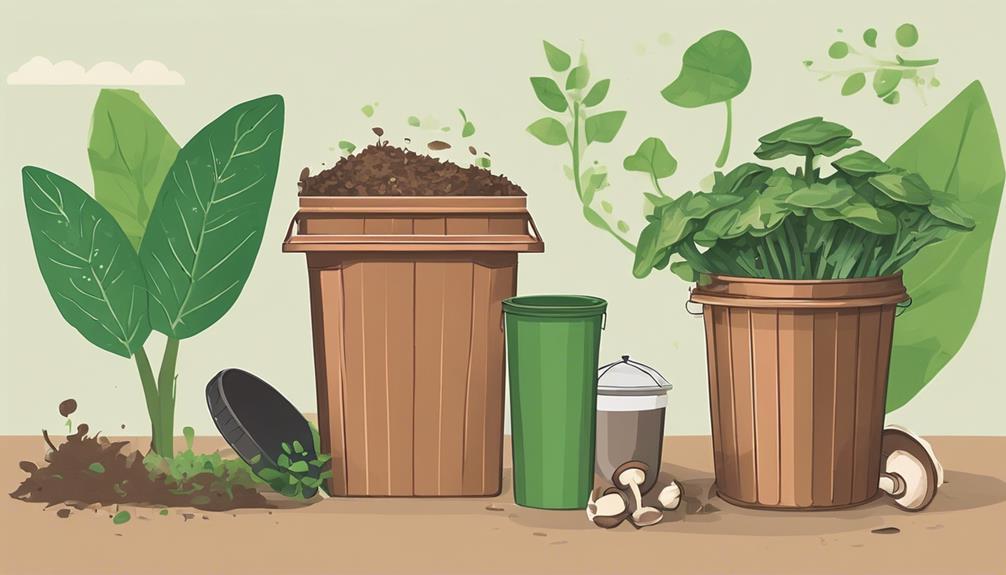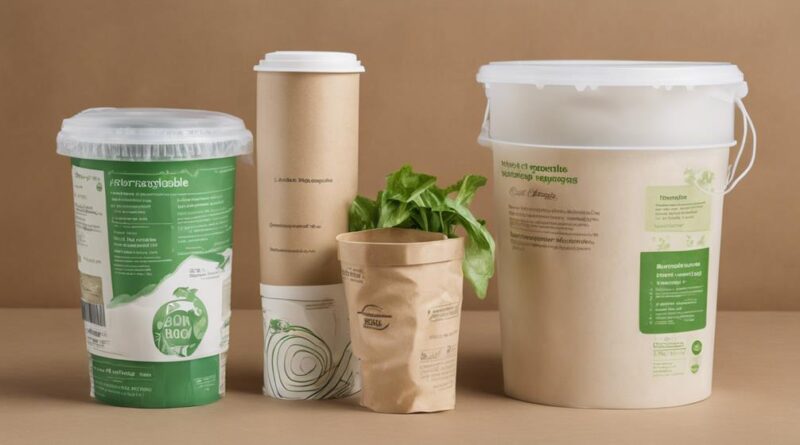Why Is Organic Packaging Better for the Environment?
Organic packaging is better for the environment due to reduced carbon footprint, biodegradable materials, lower energy consumption, minimal chemical usage, and less plastic waste generation. It decreases carbon emissions, utilizes renewable resources, saves energy, and reduces chemical usage, all supporting a greener future. Sustainable practices in packaging align with consumer preferences and promote waste reduction. Additionally, compostable options offer eco-friendly solutions catering to environmentally conscious individuals. This eco-focused approach fosters resource conservation and attracts consumers seeking environmentally responsible products. Organic packaging embodies a holistic environmental strategy.
Reduced Carbon Footprint
Organic packaging significantly decreases carbon emissions throughout the production and distribution process, thereby contributing to a more sustainable supply chain. Energy-efficient practices play a vital role in reducing the carbon footprint of organic packaging. By utilizing renewable energy sources and optimizing production processes, companies can lower their overall energy consumption and greenhouse gas emissions.
Sustainable transportation is another key aspect that helps in reducing carbon emissions when using organic packaging. Companies that opt for eco-friendly transportation methods, such as electric vehicles or biodiesel trucks, can significantly decrease the environmental impact of their supply chain operations. By choosing sustainable transportation options, businesses can lower their carbon emissions and help combat climate change.
Studies have shown that organic packaging, coupled with energy-efficient practices and sustainable transportation, can lead to a substantial reduction in carbon emissions compared to traditional packaging methods. Implementing these strategies not only benefits the environment but also aligns with consumer preferences for eco-friendly products. As more companies adopt these sustainable approaches, the overall carbon footprint of the packaging industry is expected to decrease significantly, paving the way for a more environmentally friendly future.
Biodegradable Materials Used
Using biodegradable materials in packaging can further enhance the sustainability of your supply chain by promoting environmental responsibility and reducing waste. Natural fibers, such as jute, hemp, or cotton, are excellent examples of biodegradable materials that can be utilized in packaging. These materials are sourced from plants, making them renewable resources that have minimal environmental impact compared to traditional plastics.
Green alternatives like biodegradable plastics derived from plant starches or polylactic acid (PLA) offer similar functionalities to conventional plastics but with the added benefit of being biodegradable. PLA, for instance, is produced from fermented plant starch (usually corn) and is compostable under the right conditions. This not only reduces the dependency on fossil fuels but also helps in cutting down the carbon footprint associated with packaging production.
Research indicates that the use of biodegradable materials in packaging has a significant positive impact on waste reduction. By choosing packaging materials that can naturally decompose, you contribute to reducing the amount of non-biodegradable waste that ends up in landfills or oceans. Embracing biodegradable options is a step towards a more sustainable future, where the materials used in packaging align with the principles of a circular economy.
Lower Energy Consumption in Production
Lowering energy consumption in the production process can lead to significant cost savings and environmental benefits. Organic packaging promotes resource efficiency and sustainability by requiring less energy during manufacturing compared to traditional packaging methods. Studies have shown that organic packaging materials, such as recycled paper or biodegradable plastics, generally have lower energy requirements in their production processes. This reduced energy consumption not only helps in cutting down production costs but also contributes to a reduced environmental impact.
The use of renewable energy sources further enhances the sustainability of organic packaging production. By utilizing solar, wind, or hydroelectric power in manufacturing facilities, companies can significantly decrease their carbon footprint and reliance on non-renewable energy sources. This shift towards renewable energy aligns with the principles of sustainability and helps in lowering greenhouse gas emissions.
Moreover, the emphasis on lower energy consumption in organic packaging production can drive innovations in manufacturing processes. Companies are increasingly investing in energy-efficient technologies and practices to reduce their operational costs and environmental footprint. By optimizing energy usage and implementing sustainable production methods, businesses can achieve a competitive edge in the market while contributing to the overall goal of environmental conservation. In conclusion, prioritizing lower energy consumption in organic packaging production not only benefits companies in terms of production costs but also plays a vital role in promoting environmental sustainability.
Minimal Chemical Usage
Minimizing the use of chemicals in packaging production processes is crucial for enhancing environmental sustainability and reducing potential health hazards. Natural preservation methods offer a promising alternative to synthetic chemicals commonly used in packaging. These methods, such as antimicrobial agents derived from plants and essential oils, can effectively extend the shelf life of products without the need for harmful chemicals. By utilizing natural preservation methods, packaging manufacturers can reduce the environmental impact of their products while ensuring consumer safety.
Green packaging alternatives also play a significant role in minimizing chemical usage. Materials such as recycled paper, cardboard, and biodegradable plastics offer sustainable options that require fewer chemicals during production. These green alternatives not only help reduce the reliance on harmful chemicals but also contribute to lowering carbon emissions and energy consumption throughout the packaging lifecycle.
Research has shown that the adoption of natural preservation methods and green packaging alternatives can significantly decrease the environmental footprint of packaging materials. By choosing eco-friendly options that prioritize minimal chemical usage, businesses can align with sustainable practices that benefit both the environment and human health. Making informed decisions about packaging materials is essential for promoting a greener future and reducing the overall impact of chemical pollution on our planet.
Less Plastic Waste Generation
To further advance environmental sustainability in packaging production, consider exploring methods that lead to less plastic waste generation. Plastic waste poses a significant threat to the environment, with millions of tons ending up in landfills and oceans each year. By opting for eco-friendly alternatives and implementing waste reduction strategies, the impact of plastic packaging can be minimized.
One effective approach to reducing plastic waste generation is by utilizing compostable packaging materials. These materials are derived from renewable resources such as plant-based plastics or biodegradable polymers, which break down naturally without leaving behind harmful residues. By incorporating compostable packaging into your production process, you can significantly decrease the amount of plastic waste that accumulates in the environment.
Another key strategy for reducing plastic waste is through the use of recyclable packaging. Designing packaging that's easily recyclable ensures that the materials can be repurposed rather than disposed of in landfills. By encouraging consumers to recycle their packaging and working with recycling facilities to streamline the process, you can contribute to a more circular economy where materials are reused efficiently.
Sustainable Sourcing Practices
Implementing sustainable sourcing practices in your packaging production is crucial for reducing environmental impact and ensuring long-term viability. When considering ethical sourcing and eco-conscious manufacturing, you're making a significant contribution to the overall sustainability of your packaging materials.
Here are three key aspects to focus on:
- Supply Chain Transparency: Ensure that your suppliers follow ethical sourcing practices by providing transparency into their processes. This involves verifying that raw materials are sourced responsibly, workers are treated fairly, and environmental standards are met. By choosing suppliers with transparent supply chains, you can be confident in the ethical practices behind your packaging materials.
- Local Sourcing: Opt for locally sourced materials whenever possible to reduce the carbon footprint associated with transportation. Local sourcing not only supports the community but also helps minimize the environmental impact of long-distance shipping. By prioritizing local suppliers, you can promote sustainability and reduce the overall environmental footprint of your packaging production.
- Certifications and Standards: Look for certifications such as Forest Stewardship Council (FSC) or Sustainable Forestry Initiative (SFI) to ensure that your materials come from responsibly managed forests. These certifications guarantee that the wood and paper products used in your packaging have been sourced sustainably. Adhering to recognized standards demonstrates your commitment to eco-conscious manufacturing practices and reinforces the credibility of your sustainable packaging efforts.
Compostable Packaging Options

Utilizing compostable packaging materials presents a sustainable solution for reducing environmental impact in the packaging industry. These options are made from renewable resources, such as plant-based materials like cornstarch, sugarcane bagasse, or bamboo, which are biodegradable and can be broken down into natural elements. The innovative designs of compostable packaging cater to eco-conscious consumers who are increasingly prioritizing sustainability in their purchasing habits.
Market trends indicate a growing demand for eco-friendly packaging solutions, with consumers showing a willingness to pay a premium for products that align with their values. This shift towards sustainability has led to a surge in the availability and variety of compostable packaging options in the market.
Compostable packaging not only reduces the reliance on non-renewable resources but also minimizes pollution and waste generation. When disposed of properly in composting facilities, these materials break down into organic matter without leaving behind harmful residues. This closed-loop system aligns with circular economy principles, promoting a regenerative approach to packaging production and disposal.
Support for Eco-Friendly Initiatives
Supporting eco-friendly initiatives is crucial for businesses looking to align with consumer values and contribute to a sustainable future. By incorporating renewable resources into packaging materials, companies can significantly reduce their environmental impact. Here are three key reasons why supporting eco-friendly initiatives is essential:
- Reduced Carbon Footprint: Utilizing renewable resources such as plant-based plastics or recycled materials in packaging helps decrease reliance on fossil fuels. This shift can lead to a substantial reduction in greenhouse gas emissions, thus lowering the carbon footprint of the business.
- Resource Conservation: Supporting eco-friendly initiatives promotes the efficient use of resources. By opting for materials that can be sustainably sourced and replenished, businesses contribute to the conservation of natural resources like forests, water, and minerals. This approach fosters a more sustainable production cycle and helps protect ecosystems.
- Consumer Preference and Loyalty: Today's consumers are increasingly conscious of environmental issues and seek products from companies that share their values. By actively supporting eco-friendly initiatives, businesses can attract environmentally conscious consumers, enhance brand loyalty, and differentiate themselves in the market. This consumer goodwill can translate into long-term success and profitability for the company.
Conclusion
In conclusion, the use of organic packaging offers numerous environmental benefits. From reducing carbon footprint to using biodegradable materials, the advantages are clear.
Lower energy consumption in production, minimal chemical usage, and sustainable sourcing practices further contribute to a more eco-friendly approach.
With compostable packaging options and support for eco-friendly initiatives, the shift towards organic packaging is a positive step towards a greener future. Make the switch today and help protect our planet for generations to come.
